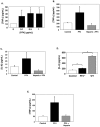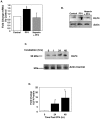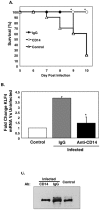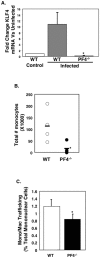Platelet factor 4 regulation of monocyte KLF4 in experimental cerebral malaria
- PMID: 20454664
- PMCID: PMC2862712
- DOI: 10.1371/journal.pone.0010413
Platelet factor 4 regulation of monocyte KLF4 in experimental cerebral malaria
Abstract
Cerebral malaria continues to be a difficult to treat complication of Plasmodium falciparum infection in children. We have shown that platelets can have major deleterious immune functions in experimental cerebral malaria (ECM). One of the platelet derived mediators we have identified as particularly important is platelet factor 4/CXCL4. Our prior work demonstrated that PF4(-/-) mice are protected from ECM, have reduced plasma cytokines, and have reduced T-cell trafficking to the brain. We now show that PF4 drives monocyte cytokine production in a Kruppel like factor 4 (KLF4) dependent manner. Monocyte depleted Plasmodium berghei infected mice have improved survival, and KLF4 is greatly increased in control, but not monocyte depleted mice. PF4(-/-) mice have less cerebral monocyte trafficking and no change in KLF4 expression. These data indicate that PF4 induction of monocyte KLF4 expression may be an important step in the pathogenesis of ECM.
Conflict of interest statement
Figures





Similar articles
-
Platelet factor 4 mediates inflammation in experimental cerebral malaria.Cell Host Microbe. 2008 Aug 14;4(2):179-87. doi: 10.1016/j.chom.2008.07.003. Cell Host Microbe. 2008. PMID: 18692777 Free PMC article.
-
Disruption of Parasite hmgb2 Gene Attenuates Plasmodium berghei ANKA Pathogenicity.Infect Immun. 2015 Jul;83(7):2771-84. doi: 10.1128/IAI.03129-14. Epub 2015 Apr 27. Infect Immun. 2015. PMID: 25916985 Free PMC article.
-
Platelet factor 4 (CXC chemokine ligand 4) differentially regulates respiratory burst, survival, and cytokine expression of human monocytes by using distinct signaling pathways.J Immunol. 2007 Aug 15;179(4):2584-91. doi: 10.4049/jimmunol.179.4.2584. J Immunol. 2007. PMID: 17675521
-
Experimental cerebral malaria: possible new mechanisms in the TNF-induced microvascular pathology.Soz Praventivmed. 1995;40(1):50-7. doi: 10.1007/BF01615662. Soz Praventivmed. 1995. PMID: 7900436 Review.
-
CXCL4-induced macrophages in human atherosclerosis.Cytokine. 2019 Oct;122:154141. doi: 10.1016/j.cyto.2017.08.021. Epub 2017 Sep 10. Cytokine. 2019. PMID: 28899579 Review.
Cited by
-
Platelet Factor 4: A Mysterious Chemokine in Inflammatory Regulation Diseases.J Inflamm Res. 2025 Mar 27;18:4481-4495. doi: 10.2147/JIR.S504673. eCollection 2025. J Inflamm Res. 2025. PMID: 40166592 Free PMC article. Review.
-
Real-time imaging reveals the dynamics of leukocyte behaviour during experimental cerebral malaria pathogenesis.PLoS Pathog. 2014 Jul 17;10(7):e1004236. doi: 10.1371/journal.ppat.1004236. eCollection 2014 Jul. PLoS Pathog. 2014. PMID: 25033406 Free PMC article.
-
CD19(+) B cells confer protection against experimental cerebral malaria in semi-immune rodent model.PLoS One. 2013 May 28;8(5):e64836. doi: 10.1371/journal.pone.0064836. Print 2013. PLoS One. 2013. PMID: 23724100 Free PMC article.
-
The role of chemokines in severe malaria: more than meets the eye.Parasitology. 2014 Apr;141(5):602-13. doi: 10.1017/S0031182013001984. Epub 2013 Dec 13. Parasitology. 2014. PMID: 24476686 Free PMC article. Review.
-
Fatal Pediatric Cerebral Malaria Is Associated with Intravascular Monocytes and Platelets That Are Increased with HIV Coinfection.mBio. 2015 Sep 22;6(5):e01390-15. doi: 10.1128/mBio.01390-15. mBio. 2015. PMID: 26396242 Free PMC article.
References
-
- van der Heyde HC, Nolan J, Combes V, Gramaglia I, Grau GE. A unified hypothesis for the genesis of cerebral malaria: sequestration, inflammation and hemostasis leading to microcirculatory dysfunction. Trends Parasitol. 2006;22:503–508. - PubMed
-
- Smyth SS, McEver RP, Weyrich AS, Morrell CN, Hoffman MR, et al. Platelet functions beyond haemostasis. J Thromb Haemost 2009 - PubMed
Publication types
MeSH terms
Substances
Grants and funding
LinkOut - more resources
Full Text Sources
Other Literature Sources
Molecular Biology Databases
Miscellaneous

